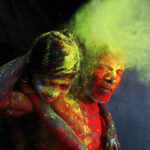Colors are more than just visual elements; they are the soulful notes in the symphony of photography. They can set the mood, tell a story, or elevate an ordinary scene into something mesmerizing. In photography, understanding and utilizing colors is crucial in creating impactful imagery. Let’s delve deeper into the world of colors and how they shape our photographic narrative.
1. The Emotional Resonance of Colors
Every color has an emotional undertone. Bright yellows often evoke feelings of happiness and energy, while deep blues can usher in calmness or melancholy. A photograph draped in warm reds and oranges can transport viewers to a cozy autumn evening, whereas a palette dominated by cold greens and blues can convey mystery or serenity.
2. Color Harmony in Composition
The color wheel isn’t just for painters; photographers benefit from it too. Understanding complementary (opposite) colors, analogous (side-by-side) colors, and triadic (triangle) color schemes can guide us in composing images that are harmonious to the eye. For instance, a sunset photo combining the fiery orange of the sky with the deep blue of the ocean is a classic example of complementary colors at play.
3. The Magic of Golden and Blue Hours
The time of day impacts the color temperature of the light, which in turn affects how subjects are illuminated. Golden hours—shortly after sunrise and before sunset—bathe everything in a warm, golden hue. The blue hour, which occurs just before sunrise and after sunset, envelops scenes in cool, bluish tones. Recognizing these hours and their respective color casts can be a game-changer.
4. Post-Processing: Enhancing & Manipulating Colors
While the goal is to capture the best colors in-camera, post-processing tools like Lightroom or Photoshop allow photographers to enhance or modify the colors in an image. Saturation, vibrance, hue, and color balance are some of the tools at our disposal. However, a word of caution: over-manipulation can render images unnatural.
5. Monochrome: The Absence of Colors
Ironically, understanding color photography also means appreciating its absence. Monochrome or black and white photography focuses on contrast, light, and shadows, teaching us that sometimes, the absence of color can convey a story more powerfully than a burst of hues.
Colors are the silent storytellers in an image, and understanding their language can profoundly enhance our photographic journey. Whether you’re a novice just starting out or a seasoned professional, take a moment during your next shoot to truly see and feel the colors around you. Let them guide your lens and narrative. After all, in the world of photography, colors are the notes that make up our visual symphony.











